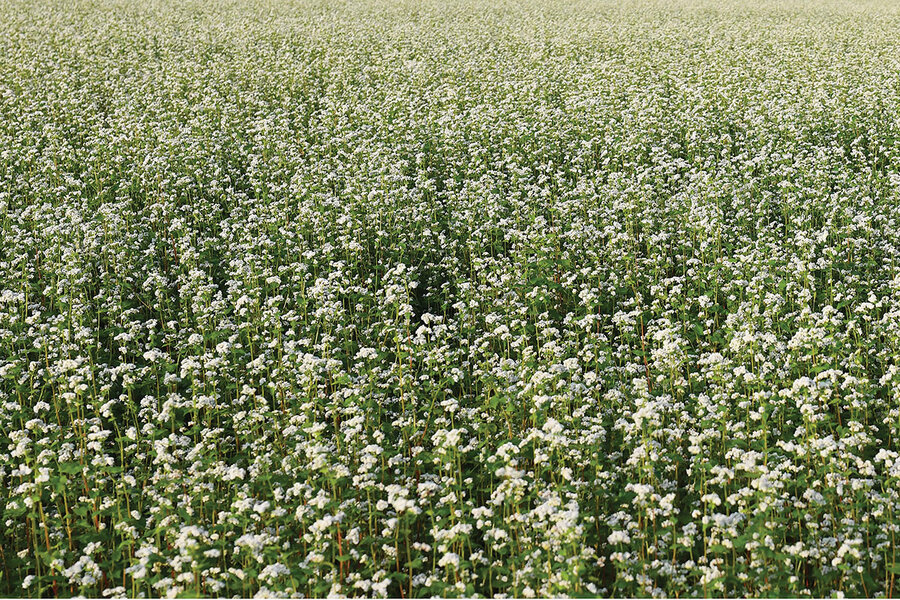1. United States
Apprentice programs are giving young people lucrative career paths while filling employment holes. Registered apprentice programs are highly successful: 93% of apprentices are employed after their training, earning an average starting salary of $77,000, according to the U.S. Department of Labor. In the decade following 2009, the number of training programs increased by 73%, with over 3,000 added in 2020 alone.
One fire department in southern Oregon doubled staffing this year through apprenticeships, after experiencing a serious first responder shortage. Prohibitive costs borne by trainees used to make it difficult to recruit. So in February, the agency launched a paid apprenticeship program with state funding that has brought in 21 new firefighters, allowing the department to hire a more diverse set of candidates.
Why We Wrote This
In our progress roundup, an embrace of tradition improves job training in the US. And in the Netherlands, bringing back flowering buckwheat as a crop is paying off in biodiversity – and old-fashioned pancakes.
In Indianapolis, new apprenticeship programs are training high school and community college students for work in local business, IT, manufacturing, and the medical field while they study. The idea emerged after a group of business and community leaders visited Switzerland to study its apprenticeship model. “Seeing the connectivity between government, employers, associations, the school system,” said Stephanie Bothun, vice president of Ascend Indiana, “I came back like, we have to … make this a core piece of our solution.”
Sources: KATU, The 74
2. Netherlands
Dutch farmers are reviving buckwheat, a traditional crop loved by pollinators. Buckwheat was one of the most common crops in the Netherlands two centuries ago. But the grainlike seed was gradually replaced by higher-yield, lucrative crops like potatoes. Today, 23 farms covering 85 hectares (210 acres) in the provinces of Groningen and Drenthe are now successfully growing buckwheat as part of a project to improve biodiversity in the region.
The plant’s long flowering period, from June through August, provides rich nectar for honeybees and other pollinators. “At any given moment during peak flowering, one hectare of the buckwheat field has an average of 6,500 wild pollinators,” says Thijs Fijen, an assistant professor at Wageningen University. “This includes 28 species of hoverfly, 12 species of wild bee, and 13 species of butterfly.”
In recent years, the market for buckwheat has expanded as consumers look for more gluten-free, high-fiber, and antioxidant-rich options. Though sensitive to frost, buckwheat grows well in the nutrient-poor, sandy soils in the eastern part of the country; enhances soil health; suppresses weeds; and has few known pests.
Source: The Guardian
3. India
India’s multidimensional poverty index fell dramatically in a period of 15 years. Researchers have long recognized the concept of poverty as more complex than income alone. The Multidimensional Poverty Index, developed by the Oxford Poverty and Human Development Initiative and the United Nations Development Program, incorporates data from 10 indicators in the areas of health, education, and standard of living.
In India, the MPI fell from 0.283 to 0.069 between surveys conducted in 2005-2006 and again in 2019-2021, according to a 2022 report. Children saw the fastest reduction. While India is still home to the greatest number of people living in poverty worldwide, and both the pandemic and global inflation have posed setbacks, some 415 million people exited poverty using conventional measures during the 15-year timespan, for a drop from 55.1% to 16.4%. Policies that improved access to sanitation, cooking fuel, and electricity helped make the largest improvements.
Sources: UNDP, Oxford Poverty and Human Development Initiative
4. Indonesia
Indonesia’s Raja Ampat demonstrates how effective protected areas can be when grounded in local management traditions. Things haven’t always looked promising for the region spanning 2 million hectares (4.9 million acres), including 1,411 islands, in the heart of the Coral Triangle reef system. Home to 75% of the world’s known coral species, Raja Ampat was in decline two decades ago due to unregulated commercial fishing and poaching, according to the national foundation Konservasi Indonesia. The site was added to West Papua’s Bird’s Head Seascape initiative in 2004 to preserve the marine ecosystem while working closely with locals.
Earlier this year, the network was issued the Blue Parks Award, given to marine parks meeting the highest science-based standards for conservation. And researchers have documented Raja Ampat’s Wayag Lagoon as a key nursery for the reef manta ray. While conservationists warn against getting too comfortable, strong partnerships with local communities offer hope. “This holistic approach will give the best chance of success,” said Marit Miners, co-founder of the Misool Eco Resort. “It takes a whole lot of spirit and energy, which is found here in Raja Ampat.”
Sources: CNN, Mongabay, Marine Policy
5. Vanuatu
Vanuatu is the first Pacific Island country free from trachoma. A leading cause of preventable blindness, trachoma was found in 12% of children in Vanuatu between the ages of 1 and 9 less than a decade ago. Today, the virus is no longer a public health concern for the island’s 300,000 residents, and Vanuatu is one of 14 countries that have eliminated it.
Trachoma is one of 20 so-called neglected tropical diseases, which generally affect populations in low-income parts of the world where access to health care is limited. “This success demonstrates the strong commitment of health workers, communities and governments to protecting their people and ensuring healthier lives for all,” said World Health Organization Director-General Tedros Adhanom Ghebreyesus about Vanuatu’s success.
Source: World Health Organization



